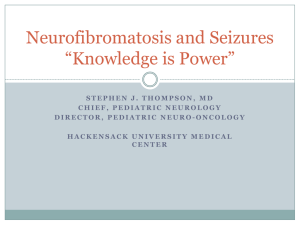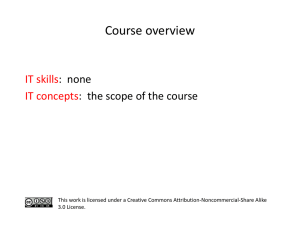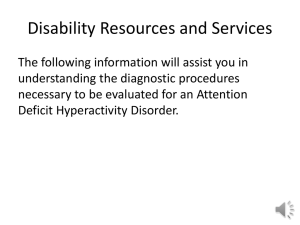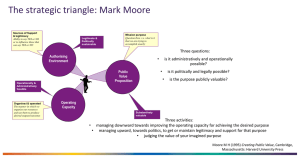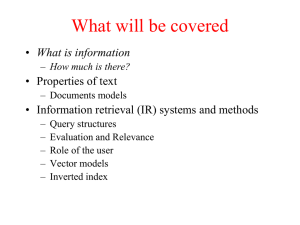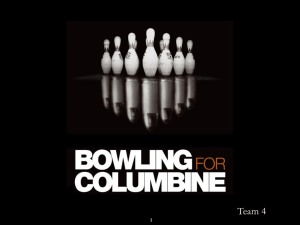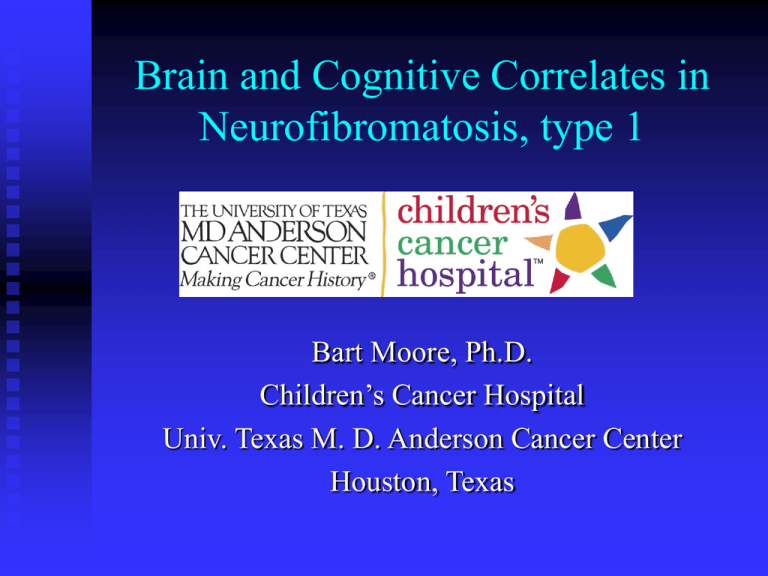
Brain and Cognitive Correlates in
Neurofibromatosis, type 1
Bart Moore, Ph.D.
Children’s Cancer Hospital
Univ. Texas M. D. Anderson Cancer Center
Houston, Texas
Background
History of NF1
First
Description
Recognized for centuries
Friedrich von Recklinghausen
• 1882
Genetic nature noted in early 1900s
Causative gene identified 1990
Background
Genetics
Autosomal
dominant disorder
Fully penetrant, variably expressed
Mutations in NF1 gene
Located on chromosome 17q11. 3
Produces
neurofibromin
Background
Mortality
Phenotypic
features increase with age
Shortened life-span
Childhood deaths
Intracranial tumors
MPNST, Leukemia, or embryonal tumors
Adult Deaths
MPNST, and sarcomas
GI bleeding, severe seizures, hydrocepahlus, and
hypertension
General Features of
Neurofibromatosis, type 1 (NF)
Autosomal dominant genetic disorder resulting from a
mutation on chromosome 17
Has an incidence of about 1 in 3500
One-half of new cases are spontaneous mutations (50%
are inherited)
Offspring of a parent with NF have about a 50-50
chance of inheriting the disorder
Clinical manifestations are quite variable, but generally
become more severe with age
Often mistaken for the “Elephant-Man” syndrome
(Proteus syndrome)
Currently, there is no cure or effective treatment
Clinical Features of NF
Cutaneous café-au-lait spots
Axillary freckling
Subcutaneous neurofibromas
Plexiform neurofibromas
Brain tumors, primarily optic glioma
Orthopedic malformations (eg., scoliosis)
Family history
A diagnosis of NF requires two of the above criteria
Macrocephaly
Learning disability and behavioral problems
What makes NF-1 so interesting from a
neuropsychological standpoint
40-50% incidence of learning disability, specific
cognitive impairments (eg., visual spatial
abilities), and ADHD
60-70% incidence of brain “hyperintensities” in
cortical and subcortical white matter (UBOs) in children
but not adults
Cognitive profile similar to traumatic brain
injury (language deficits are also common).
15-20% incidence of brain tumors
Could there be a neuroanatomical basis for the
cognitive and behavioral features of NF-1?
30-40% incidence of macrocephaly
Cognitive, Learning, Behavioral, and Neuroanatomical
Features of NF-1: Is There a Connection?
Neurological Factors
Cognitive
Impairments
Learning
Disability
Brain tumors
UBOs
Behavioral
Factors
Macrocephaly
White matter?
Corpus Callosum??
Intelligence in Children and Adolescents with NF:
A Meta Analysis
No. of
patients
67
% MR
11.4
Mean
FSIQ
90
Varnhagen et al. (1988)
16
NA
94.5
VIQ = PIQ
NA
Wadsby et al. (1989)
27
11
NA
VIQ > PIQ
59
Stine and Adams (1989)
18
NA
91.8
VIQ = PIQ
41
Eldridge et al. (1989)
13
NA
93.9
PIQ > VIQ
NA
North et al. (1994, 1995)
50
4.8
93.3
VIQ = PIQ
45
Legius et al. (1994)
38
5.2
89.9
VIQ > PIQ
61
Moore et al. 1994, 1996)
65
6
92.9
PIQ > VIQ
30
Denckla et al. (1996)
19
NA
94.8
NA
NA
Ferner et al. (1996)
103
8
88.6
PIQ = VIQ
NA
(416)
7.1%
92.9
Riccardi & Eichner (1986)
AVERAGE
(From North, et al, 1997)
VIQ and PIQ % LD
NA
30
44.3
Math Performance
Proportion with scores at
least 1 SD below average
Academic Profile
It is commonly reported that 40% have a
cognitive or learning disability
50% are described by parents as having
“school problems”
One-third have repeated a grade
One-half are in a special class
(N=90)
Pediatric Research, 1994,35:25 (abstract)
Longitudinal research using individual
growth curve statistical methodology
In general, growth in math and overall IQ is
positive and comparable to normal, but
lower.
But growth in Verbal IQ declines with age
Presence of UBOs resulted in faster growth
in Performance IQ
Long, Swank, Slopis, Moore (2000). Cognitive profile and academic achievement
of children with neurofibromatosis: a longitudinal study using individual growth
curves. J Intl Neuropsychological Soc,6(2):165.
What could cause these problems?
Cranial tumors
Brain “hyperintensities”
Macrocephaly
Abnormalities of cortical development
Abnormalities of cortical function
CNS Tumors in NF 1
In patients referred for non-ophthalmologic
reasons to NF clinic:
15% had optic gliomas
<20% with gliomas were symptomatic
Listernick et al. J Pediatr 1989;114:788-92
Optic Nerve & Pathway Gliomas
COG A9952 CHEMOTHERAPY FOR PROGRESSIVE LOW GRADE
ASTROCYTOMA IN CHILDREN LESS THAN TEN YEARS OLD
A Phase III Intergroup COG Study
PRIMARY GOALS
To compare the event-free survival as a result of treatment with either carboplatin
and vincristine (CV*) or a combination of thioguanine, procarbazine, CCNU, and
vincristine (TPCV).
SECONDARY GOALS:
To estimate tumor response, toxicity, and QOL to each regimen of chemotherapy.
To investigate biological and clinical factors which may predict tumor response
To investigate factors contributing to neuropsychological and endocrine status
* NF-1 patients non-randomly assigned to CV regimen
Eligibility for COG 9952
Residual tumor after surgery or radiographic
diagnosis
Further resection would cause unacceptable
morbidity
Age less than 10 years old to delay radiation
Evidence of tumor progression
Objective growth on MRI - Required for NF
Progressive symptoms prior to diagnosis
Brain Tumors in Children with Neurofibromatosis:
Additional Neuropsychological Morbidity?
De Winter AE, Moore BD, Slopis JM, Ater JL, Copeland DR, (2000).
Neuro Oncology, 1(4):275-281.
Matched group analysis: Mean neuropsychological
domain scores for NF-alone (n = 36) and NF + brain
tumor (n = 36) groups
Domain
Intellectual
Full Scale IQ
Verbal IQ
Performance IQ
Academic Achievement
Language
Memory
Visual-Motor
Visual-Spatial
Motor
Attention
NF Alone
Mean (SD)
NF + BT
mean (SD) Prob.
91.7 (14.3)
92.6 (14.6)
92.2 (13.9)
89.3 (13.5)
9.1 (3.0)
8.4 (3.1)
7.9 (2.5)
6.1 (3.9)
9.1 (3.9)
8.2 (2.3)
92.9 (15.3)
91.3 (15.1)
96.3 (16.6)
86.1 (14.8)
8.8 (2.8)
7.1 (2.8)
7.3 (2.6)
5.8 (2.7)
8.1 (3.3)
7.9 (2.3)
NS
NS
NS
NS
NS
.07 (marginal)
NS
NS
NS
NS
De Winter, Moore, Slopis, Ater, & Copeland (1999) Neuro Oncology 1(4);275-281.
NF MRI Hyperintensities, or
UBOs (“unidentified bright objects”)
If UBOs diminish with age,
does that mean learning disabilities will also?
Frequency of UBOs by age among 657 NF1
patients aged 2 to 21 years
DeBella, Poskitt, Szudek and Friedman, Use of "unidentified bright objects"
on MRI for diagnosis of neurofibromatosis 1 in children. Neurology
2000;54:1646-1651
MRI of 41 year old man with optic glioma and
pheochromocytoma, but not NF-1
Neuropsychological Comparisons
Patients with NF (n=46)
MEASURE
Verbal IQ
Perf. IQ
Academic Ach.
Language
Memory
Visual Spatial
Fine Motor
FDDQ
JLO
Age
Comparisons
Without
With
Control
+/NF vs.
hyperintensity hyperintensity Subjects Hyperi Controls
(n=34)
(n=12)
(n=19)
ntensity
92.1 (18.4)
98.2 (14.7) 97.8 (11.0)
ns
ns
93.3 (18.2)
96.8 (14.4)
99.6 (9.0)
ns
ns
93.5 (17.6)
90.7 (13.2) 100.7 (10.6)
ns
p<0.05
8.3 (3.5)
10.0 (2.2)
9.6 (2.1)
ns
ns
9.8 (3.2)
8.5 (2.9)
9.5 (3.3)
ns
ns
7.4 (3.7)
6.2 (3.2)
9.3 (1.7)
ns
P<0.001
8.8 (2.6)
7.9 (2.9)
8.0 (3.6)
ns
ns
9.1 (3.2)
8.6 (2.4)
9.9 (2.1)
ns
ns
5.8 (5.2)
3.6 (3.5)
9.3 (3.1)
ns
p<0.001
122.9 (28.8)
135.7 (38.4) 129.0 (34.2)
ns
ns
School performance for those with and without
hyperintensities
No Hyperintensity Hyperintensity Chi2 (df),P
Academic/school problems
58 %
46 %
2.00 (1), ns
Repeated a grade
31 %
35 %
0.86 (1), ns
In special classes
41 %
47 %
1.03 (1), ns
So, the mere presence of UBOs
does not seem to explain the
neurocognitive deficits of
children with NF-1
What about their location???
Thalamus
Basal Brainstem Cerebral
Ganglia
Cortex
Cerebellum
Optic
paths
Moore BD, et al. (1996). Neuropsychological significance of areas of high signal
intensity on brain MRIs of children with neurofibromatosis. Neurology, 46, 1660-8.
Visual Spatial and Visual Motor Tasks are a
diagnostic predictor of NF-1
The multivariate combination of visual-spatial/motor
tasks proved to be a strong confirmatory test of NF1
diagnosis in that it correctly identified 90% of
individuals with clinically identified NF1 (p = .0007)
Schrimsher GW, Billingsley RL, Slopis JM, Moore BD
(2003). Visual-Spatial performance deficits in children with
neurofibromatosis type-1. Am J Med Gen. 120A(3):326-30
In the general population ADHD is
more frequently diagnosed in boys
than girls
Girls more frequently receive
the diagnosis of ADD while
boys are mostly ADHD or
combined
What is the pattern of ADHD in children
with NF-1?
ADHD Incidence, Subtypes, and Sex Ratios for
91 Children with NF-1
Inattentive Hyperactive
All
Girls
Boys
Combined
Total
14/41
(34.1%)
9/41
(22.0%)
18/41
(43.9%)
41/91
(45.1%)
4/16
(25.0%)
7/16
(43.8%)
5/16
(31.3%)
16/41
(39.0%)
10/25
(40.0%)
2/25
(8.0%)
13/25
(52.0%)
25/50
(50.0%)
Children in the general population with
ADHD are reported to have
abnormalities in the morphology of the
corpus callosum
It is commonly reported that children with
NF-1 have a high incidence (40-50%) of
ADHD
Corpus Callosum, NF, & ADHD
De Winter, et.al., 1999
Related Studies: ADHD vs. controls
Filipek et al. (1997): decreased volumes for
subjects with ADHD
Hynd et al. (1991): smaller regional areas
for ADHD group
Semrud-Clikeman et al. (1994): smaller
splenium measurements for ADHD group
Giedd et al. (1994): smaller rostral and
rostral body areas for ADHD group
Corpus Callosum Morphology
Cro s
e c tio nalAre a (m
m
q)
s
Cro se ctio nalAre a ofth e Corp usCallo su m
180
160
140
120
1 00
80
60
40
20
0
* p<0 . 0 1
*
1
2
3
N F p a tie n ts
* *
4
5
C o n tro ls
6
7
Brain Volume in Children with
Neurofibromatosis, Type 1:
Relation to Neuropsychological Status
Moore BD, Slopis JM, Jackson EF, De Winter A, Leeds NE, (2000).
Neurology,2000,54:914-920.
Moore, et.al., 2000
Brain Size
The BIG MAC hypothesis
“This law of proportion of course governs the
brain, as well as all else in Nature. …..Large
brains must be, and are, more efficient than
small ones, when the quality of both is
alike…..”
Fowler OS. Human Science, or Phrenology. New York,
Fowler & Wells, 1873 Washington, DC: 164-165.
Bilateral Basal Ganglia Hyperintensities
Moore, et.al., In Press
Brain Volumes (Cm3) from
MRI Segmentation
MEASURE NF Patients (n=52)
Control Subjects (n=18)
Prob.
Total Brain
1476 (190.4)
1316.3 (136.72)
p<0.002
Left Hemisphere
735.4 (94.1)
654.2 (69.0)
p<0.002
Right Hemisphere
741.5 (96.5)
650.8 (47.9)
p<0.002
White Matter
588.1 (120.7)
568.9 (89.5)
ns
Gray Matter
888.7 (129.1)
747.4 (99.2)
p<0.0001
Cerebrospinal Fluid
105.9 (49.1)
89.0 (24.2)
ns
5.02 (8.1)
-------------------
--------
Hyperintensity
Moore, et.al., In Press
IQ-Aca d . Ach . Di scre p a n cy
Total Gray Matter Volume and
IQ-Academic Achievement Discrepancy
40
30
20
10
R=0.73
0
r 0.7 3
=
pp<0.001
<0.001
-1 0
-2 0
-3 0
600
700
800
900
1000 1100 1200 1300 1400
To ta l Gra y M a tte r Vo l u m e (c c )
Moore, et.al., 2000, Neurology, 54:914-920
Gray/White Matter Ratios
Relationship with Age
Gray/White Matter volume
2.50
NF: r = - 0.62, P= 0.0001
Controls: r = - 0.20, P = 0.45
NF
2.00
patients
1.50
Control
Subjects
1.00
0.50
2 3 4 5 6 7 8 9 101112131415161718
Age in years
Regional Cortical Morphology
in NF-1
Reading disabilities and developmental language
impairments in the general population have been
associated with particular morphologic features in
the inferior frontal gyrus (IFG) and Heschl’s gyrus
(HG).
Billingsley, Slopis, Swank, Jackson, & Moore (2003)
Brain and Language, 85:125 – 139.
Type I, “typical”
Type II, typical
Type IIIc, atypical
Factor Z-Score
Relationship between language scores, group, and
inferior frontal gyrus classification in the right
hemisphere
3
2
1
0
-1
-2
-3
-4
-5
Phonological
Fluency
Verbal
Knowledge
Reading and
Spelling
Verbal Memory
Typical
Atypical
Typical
Atypical
(n=22)
(n=16)
(n=17)
(n=21)
NF-I
CONTROL
Heschl’s Gyrus (HG)
Leonard et al. (1993, 2001) reported an
increased incidence of HG duplication in
individuals with dyslexia in the general
population,
Inferior Frontal Gyrus Results
Atypical IFG morphology involving an extra gyrus in the right
hemisphere was associated with better performance on languagerelated measures for the NF-1 group.
An extra gyrus in right inferior frontal cortex was associated with
better scores on phonological fluency, verbal knowledge, reading and
spelling, and verbal memory factors.
Heschl’s Gyrus Results
In the left hemisphere, HG duplication was associated with poorer
performance on verbal memory for both groups.
HG duplication in the right hemisphere for participants with NF-I,
however, was associated with better performance on math, and verbal
memory.
Sylvian Fissure
Morphology and
Reading
Normally, there is a left>right asymmetry of the
planum temporale. An absence of this asymmetry or
rightward asymmetry is seen in reading-impaired
populations.
Results of Planum Temporale study
Boys with NF-1 showed less asymmetry of the PT than girls
with NF-1 or than the Control group regardless of gender.
Less asymmetry in the PT was associated with poorer
performance relative to full-scale IQ in the NF-I group.
This might indicate that hemispheric specialization for language
is less developed in those with NF-1 than in the general
population.
Billingsley, Schrimsher, Jackson, Slopis, & Moore (2002). Significance
of planum temporale and planum parietale morphology in
neurofibromatosis, type-1. Archives of Neurology, 59: 616-622.
Structure/Function----Cause and Effect
Houston Art Car
Parade
BOLD Contrast
BOLD = Blood Oxygenation Level Dependent
Increase in oxyhemoglobin in veins after neural
activation means magnetic field becomes more
uniform inside voxel
How FMRI Experiments Are Done
Alternate subject’s neural state between 2 (or more)
conditions using sensory stimuli, tasks to perform, ...
Can only measure relative signals, so must look for changes
Acquire MR images repeatedly during this process
Search for voxels whose signal follows the stimulus
Signal changes due to neural activity are small
Need 50+ images in time series (each slice) takes minutes
Other small effects can corrupt the results postprocess
Some Sample Data Time Series
Task: phoneme discrimination:
20 s “on”, 20 s “rest”
graphs of 9 voxel time series
“Active” voxels
t
One Fast
Image
Graphs vs. time of 33 voxel
region
This voxel did
not respond
Overlay on
Anatomy
Colored voxels responded to the mental
stimulus alternation, whose pattern is shown in the
yellow reference curve plotted in the central voxel
Letter Fluency Task, N = 14, p < 0.005 (ccz 0.24)
Passage Comprehension, N = 10, p < 0.005 (ccz 0.25)
4
2
4
2
21/2
2
21/2
2
Functional MRI Results
NF group showed greater right RH activation during an auditory
phonetic task than did the controls.
NF group showed greater posterior than anterior activation during
an orthographic phonetic task-opposite pattern as seen in the
controls.
NF group relied more than controls on posterior cortex relative to
inferior frontal during a visual spatial task.
Conclusion: NF patients rely more on posterior cortex and the right
hemisphere to perform tasks normally subserved by frontal cortex
and the left hemisphere.
Billingsley RL, Jackson EF, Slopis JM, Swank PR, Mahankali S, Moore BD. (2003)
Functional MRI of phonological processing in neurofibromatosis, type-1. Journal of
Child Neurology, 18:731-740
Billingsley RL, Jackson EF, Slopis JM, Swank PR, Mahankali S, Moore BD (2004).
Functional MRI of visual-spatial processing in neurofibromatosis, type 1.
Neuropsychologia, 42:395-404.
Overall Conclusions
Exploring Brain / Behavior relations is beginning to shed light on
possible etiologies for learning and cognitive difficulties in
individuals with NF-1
Disorders of language, in addition to visual spatial abilities, may
have a demonstrable underlying neurological basis.
Promising avenues of research
Abnormalities in gross brain development: gray and white matter,
corpus callosum, etc.
What is the relation between abnormal brain development and
learning status over the life span.
Regional morphological analyses of brain structure.
Functional methods such as PET, MRS, and fMRI
And Lastly
Is the NF-1 mutation responsible for altered
structural and physiological brain
development?
Are the learning and cognitive problems so
prevalent in those with NF-1 amenable to
pharmacological intervention?
Research Support
Cheniere Energy: Making Cancer History cycle team in the
Race Across America 2005,2006
National Institute of Neurological Disorders and Stroke.
“Neurobiology of Cognitive impairment in children with
NF”. R01 NS-31950 1995 to 2004
Department of Defense Congressionally Directed Medical
Research Programs (Department of Defense). “Social and
Emotional Functioning of Children with NF-1 and Their
Families: A Case Controlled Study” 1999 to 2002
Texas Neurofibromatosis Foundation, Dallas, Texas. 1993 to
1996
John Slopis, MD
Neurology
Bart Moore, PhD
Neuropsychology
Johannes Wolff, M.D.
Joann Ater, MD
Pediatric Brain tumors
Ed Jackson, PhD
Neuroimaging
Neuro Oncology
NEUROFIBROMATOSIS
CORE GROUP
Ian McCutcheon MD
Neurosurgery
Srikanth Mahankali, M.D.
Louise Strong, MD
Genetics/Epidemiology
Diagnostic Imaging
Shriner’s Hospital
Orthopedics
Trainees who contributed to this work
Rebecca Billingsley, Ph.D.; Greg Schrimsher, Ph.D.; Sandra Long, Ph.D.; Anne Kayl, Ph.D.; Christine
Randall, Ph.D.
Cindy Trotter, M.S.; Andrea Atherton, MS; Dena Buchalter, MS
Special recognition to Bernadette Kopecky, Med, Research Coordinator

